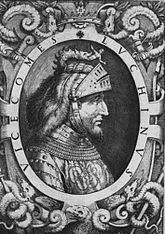Luchino Visconti (died 1349)
Luchino Visconti | |
|---|---|
| Lord of Milan and Pavia | |
 | |
| Coat of arms |  |
| Reign | 1339 - 1349 |
| Predecessor | Azzone |
| Successor | Giovanni |
| Born | 1287 or 1292 |
| Died | January 24, 1349 |
| Noble family | House of Visconti |
| Spouse(s) | Violante of Saluzzo Caterina Spinola Isabella Fieschi |
| Father | Matteo I Visconti |
| Mother | Bonacossa Borri |
| Occupation | Condottiero Podestà of Vigevano |
Luchino Visconti (also spelled Lucchino, 1287 or 1292 – January 24, 1349) was lord of Milan from 1339 to 1349.[1] He was also a condottiero,[2] and lord of Pavia.[3]
Biography
Ruler of Pavia from 1315,[4] five years later he was podestà of Vigevano, where he erected the castle that is still visible. In 1323, along with all his family, he was excommunicated with the charge of heresy. The charges of heresy and excommunication were later withdrawn[5] and he became a Papal Vicar in 1341.[4]
He co-ruled in Milan with his nephew Azzone Visconti and his brother Giovanni, until Azzones's death in 1339. He also took part in the victorious battle of Parabiago against his other nephew, Lodrisio, who had set a mercenary army to capture Milan.
With an army of mercenaries from northern Europe, which he entrusted to the sons of his brother Stefano, he expanded the duchy, capturing Pisa and buying Parma from Obizzo III d'Este.
Luchino Visconti was a patron of both music[6] and literature, having invited Petrarch to Milan.[7]
He married three times: to Violante of Saluzzo, daughter of Thomas I of Saluzzo, then to Caterina Spinola, daughter of Obizzo Spinola, and, in 1349, to Isabella Fieschi, niece of Pope Adrian V, who gave Luchino Visconti his sole legitimate son, Luchino Novello, although others of the Visconti later disputed his parentage.[8] He was a capable military commander and lord, but was also famous for his cruel behaviour.[5] In January 1349 he discovered Isabella's unfaithful behaviour, and announced for her a terrible punishment. A few days later he was found poisoned, the people soon nicknaming his wife Isabella del veleno ("Isabella of poison").
He was succeeded by his nephews Bernabò, Galeazzo and Matteo II, whom he had exiled from Milan in 1346.[2] The infidelities of Isabella were used by him and his relatives to oust Luchino Novello from the heritage.
Ancestry
| Ancestors of Luchino Visconti (died 1349) | ||||||||||||||||||||||||||||||||||||||||||||||||||||||||||||||||||||||||||||||||||||||||||||||||||||||||||||||||||||||||||||||||||||||||||||||||||||||||||||||||||||||||||||||||||||||||||||||||||||||||||||||||||||||||||||||||||||||||||||||||||||||||||||||||||||||||||||||||||||||||||||||||||||||||||||||||||||||||||||||||||||||||||||||||||||||||||||||||||||||||||||||||||||||||||||||||||||||||||||||||||||||||||||||||||||||||||||||||||||||||||||||||||||||||||||||||||||||||||||||||||||||||||||||||||||||||||||||||||||||||||||||||||||||||||||||||||||||||||||||||||||||||||||||||||||||||||||||||
|---|---|---|---|---|---|---|---|---|---|---|---|---|---|---|---|---|---|---|---|---|---|---|---|---|---|---|---|---|---|---|---|---|---|---|---|---|---|---|---|---|---|---|---|---|---|---|---|---|---|---|---|---|---|---|---|---|---|---|---|---|---|---|---|---|---|---|---|---|---|---|---|---|---|---|---|---|---|---|---|---|---|---|---|---|---|---|---|---|---|---|---|---|---|---|---|---|---|---|---|---|---|---|---|---|---|---|---|---|---|---|---|---|---|---|---|---|---|---|---|---|---|---|---|---|---|---|---|---|---|---|---|---|---|---|---|---|---|---|---|---|---|---|---|---|---|---|---|---|---|---|---|---|---|---|---|---|---|---|---|---|---|---|---|---|---|---|---|---|---|---|---|---|---|---|---|---|---|---|---|---|---|---|---|---|---|---|---|---|---|---|---|---|---|---|---|---|---|---|---|---|---|---|---|---|---|---|---|---|---|---|---|---|---|---|---|---|---|---|---|---|---|---|---|---|---|---|---|---|---|---|---|---|---|---|---|---|---|---|---|---|---|---|---|---|---|---|---|---|---|---|---|---|---|---|---|---|---|---|---|---|---|---|---|---|---|---|---|---|---|---|---|---|---|---|---|---|---|---|---|---|---|---|---|---|---|---|---|---|---|---|---|---|---|---|---|---|---|---|---|---|---|---|---|---|---|---|---|---|---|---|---|---|---|---|---|---|---|---|---|---|---|---|---|---|---|---|---|---|---|---|---|---|---|---|---|---|---|---|---|---|---|---|---|---|---|---|---|---|---|---|---|---|---|---|---|---|---|---|---|---|---|---|---|---|---|---|---|---|---|---|---|---|---|---|---|---|---|---|---|---|---|---|---|---|---|---|---|---|---|---|---|---|---|---|---|---|---|---|---|---|---|---|---|---|---|---|---|---|---|---|---|---|---|---|---|---|---|---|---|---|---|---|---|---|---|---|---|---|---|---|---|---|---|---|---|---|---|---|---|---|---|---|---|---|---|---|---|---|---|---|---|---|---|---|---|---|---|---|---|---|---|---|---|---|---|---|---|---|---|---|---|---|---|---|---|---|---|---|---|---|---|---|---|---|---|---|---|---|---|---|---|---|---|---|---|---|---|---|---|---|---|---|---|---|---|---|---|---|---|---|---|---|---|---|---|---|---|---|---|---|---|---|---|---|---|---|---|---|---|---|---|---|---|---|---|---|---|---|---|---|---|---|---|---|---|---|---|---|---|---|---|---|---|---|---|---|---|---|---|---|---|---|---|---|---|---|---|---|---|---|---|---|---|---|---|---|---|---|---|---|---|---|---|---|---|---|---|---|---|---|---|---|
| ||||||||||||||||||||||||||||||||||||||||||||||||||||||||||||||||||||||||||||||||||||||||||||||||||||||||||||||||||||||||||||||||||||||||||||||||||||||||||||||||||||||||||||||||||||||||||||||||||||||||||||||||||||||||||||||||||||||||||||||||||||||||||||||||||||||||||||||||||||||||||||||||||||||||||||||||||||||||||||||||||||||||||||||||||||||||||||||||||||||||||||||||||||||||||||||||||||||||||||||||||||||||||||||||||||||||||||||||||||||||||||||||||||||||||||||||||||||||||||||||||||||||||||||||||||||||||||||||||||||||||||||||||||||||||||||||||||||||||||||||||||||||||||||||||||||||||||||||
References
- ^ Tolfo, Maria Grazia; Colussi, Paolo (February 7, 2006). "Storia di Milano ::: I Visconti" [History of Milan::: The Visconti]. Storia di Milano (in Italian). Milano: Storiadimilano. Retrieved August 25, 2010.
- ^ a b Società Storica Lombarda, ed. (1907). "Bianca of Savoia e le sue nozze con Galeazzo II Visconti" [Bianca of Savoy and her wedding with Galeazzo II Visconti]. Archivio Storico Lombardo [Lombard Historical Archive]. Series 4 (in Italian). Vol. 7. Milano: Sede Libreria della Società Fratelli Bocca. pp. 23, 27, 30, 33. OCLC 288710340. Retrieved September 11, 2010.
- ^ Pullan, Brian S. (1972). "The Coming of the Signori". A history of early Renaissance Italy: From the mid-thirteenth to the mid-fifteenth century. New York: St. Martin's Press. p. 160. OCLC 613989155.
- ^ a b Marek, Miroslav (January 19, 2005). "Visconti 2". Genealogy.Eu. Retrieved September 13, 2010.[self-published source]
- ^ a b Chisholm, Hugh, ed. (1911). . Encyclopædia Britannica. Vol. 28 (11th ed.). Cambridge University Press. p. 128. "Lucchino made peace with the church in 1341, bought Parma from Obizzo d'Este and made Pisa dependent on Milan. Although he showed ability as general and governor, he was jealous and cruel, and was poisoned in 1349 by his wife Isabella Fieschi."
- ^ Gallo, F. Alberto (1985). "14 The courts of Lombardy". Music of the Middle Ages II. Cambridge: Cambridge University Press. p. 59. ISBN 978-0-521-28483-7. OCLC 12516508. Retrieved September 13, 2010.
- ^ Società Storica Lombarda (1874). "Società Storica Lombarda" [Petrarch]. In Brigola, Gaetano (ed.). Archivio storico lombardo giornale della Società Storica Lombarda [Historical journal of Lombard Lombard Historical Society] (in Italian). Vol. 1. Milano: Società Storica Lombarda. p. 386. OCLC 445904008. Retrieved September 13, 2010.
- ^ Williams, George L. (1998). "Two: The Papal Families at the Close of the Middle Ages, 1200-1471". Papal genealogy: The families and descendants of the popes. Jefferson, NC: McFarland. p. 34. ISBN 978-0-7864-0315-8. OCLC 301275208. Retrieved September 2, 2010.

